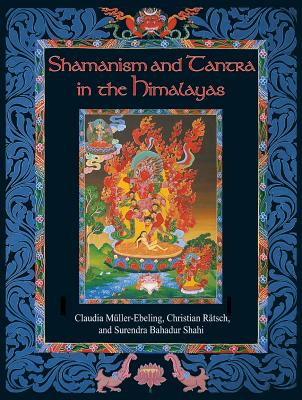You are here
Back to topShamanism and Tantra in the Himalayas (Hardcover)
$49.95
Special Order
Description
The first comprehensive guide to the shamans and tantrikas of Nepal
• 605 color and black-and-white illustrations, including 135 color thangkas.
• Includes more than 20 psychoactives never before documented.
• The result of 18 years of field research.
The Himalayan kingdom of Nepal may be the only culture in the world where both shamanic and tantric techniques are still alive and in full practice today. The result of eighteen years of field research, Shamanism and Tantra in the Himalayas presents for the first time a comprehensive overview of shamanism that is based on the knowledge and experience of the different tribes from that region. Included are original statements from the various ethnic groups and 135 color thangkas, which act as visual guides to the specific practices of the tantric tradition. In addition to the thangkas, the book is lavishly illustrated with numerous photos of different shamanic healing ceremonies, ritual objects, and culturally significant plants that have never been published before. The book also contains a wealth of original recipes, smoking mixtures, scientific tables, charts, and descriptions of more than 20 plants whose psychoactive properties and uses by shamans have never before been researched or documented.
About the Author
Claudia Müller-Ebeling, Ph.D., is an art historian and anthropologist and coauthor, with Christian Rätsch, of Shamanism and Tantra in the Himalayas, Witchcraft Medicine, and Pagan Christmas. She lives in Hamburg, Germany.
Christian Rätsch, Ph.D. (1957 – 2022), was a world-renowned anthropologist and ethnopharmacologist who specialized in the shamanic uses of plants for spiritual as well as medicinal purposes. He studied Mesoamerican languages and cultures and anthropology at the University of Hamburg and spent, altogether, three years of fieldwork among the Lacandone Indians in Chiapas, Mexico, being the only European fluent in their language. He then received a fellowship from the German academic service for foreign research, the Deutsche Akademische Auslandsdienst (DAAD), to realize his doctoral thesis on healing spells and incantations of the Lacandone-Maya at the University of Hamburg, Germany.
In addition to his work in Mexico, his numerous fieldworks have included research in Thailand, Bali, the Seychelles, as well as a long-term study (18 years) on shamanism in Nepal combined with expeditions to Korea and the Peruvian and Colombian Amazon. He also was a scientific anthropological advisor for expeditions organized by German magazines such as GEO and Spektrum der Wissenschaften (Spectrum of Sciences).
Before becoming a full-time author and internationally renowned lecturer, Rätsch worked as professor of anthropology at the University of Bremen and served as consultant advisor for many German museums. Because of his extensive collection of shells, fossils, artifacts, and entheopharmacological items, he had numerous museum expositions on these topics.
He is the author of numerous articles and more than 40 books, including Plants of Love, Gateway to Inner Space, Marijuana Medicine, The Dictionary of Sacred and Magical Plants, and The Encyclopedia of Psychoactive Plants. He is also coauthor of Plants of the Gods, Shamanism and Tantra in the Himalayas, Witchcraft Medicine, Pagan Christmas, and The Encyclopedia of Aphrodisiacs and was editor of the Yearbook of Ethnomedicine and the Study of Consciousness. A former member of the board of advisors of the European College for the Study of Consciousness (ECSC) and former president of the Association of Ethnomedicine, he lived in Hamburg, Germany.
Surendra Bahadur Shahi was born in Kathmandu into a Newari family of the Shahi caste and is an accomplished thangka painter. He speaks 10 different languages and has a thorough knowledge of the Buddhist and Hindu religion and mythology and the cultural customs of the Newari people.
Praise For…
"Shamanism and Tantra in the Himalayas provides well-documented research and insight regarding the contribution of pre-Buddhist cultures to our current understanding of Tantrism and Vajrayana. The depth of detailed knowledge regarding the symbolism, rituals, and the indigenous wisdom of the Nepali shamans can be attributed to the authors’ combined expertise in the fields of anthropology, ethnobotany, art history, and ethnography. A visionary masterpiece!"
— Alex Grey, artist and author of Sacred Mirrors and Transfigurations
"Shamanic and yogic traditions of the Indian subcontinent are closely linked together in many ways. Shamanism and Tantra in the Himalayas carefully examines the shamanic teachings of the region, along with their Hindu and Buddhist background. The book is well researched and well referenced, not merely from an academic perspective but in light of the living tradition. Anyone interested in yoga or shamanism will find a wealth of information in this fascinating book."
— David Frawley , author of Yoga for Your Type and founder of the American Institute of Vedic Studies
"An exhaustive, comprehensive, no-nonsense 300 page volume--complete with photographs of shamans in action."
— Lolita Lark, RALPH , January 2003
"Beautifully illustrated, very well written, and deeply insightful."
— J.J. Preston, CHOICE, November 2003, Vol.41 No.3
"Readers are sure to get an introduction to both ancient and modern practices that are often invisible to Western eyes."
— The Institute of Noetic Sciences, December-February 2004
"This book is big, broad, bold, and very very beautiful, literally and metaphorically, my favorite and most functional book."
— John Yost, Pan Gaia, Spring 2003
